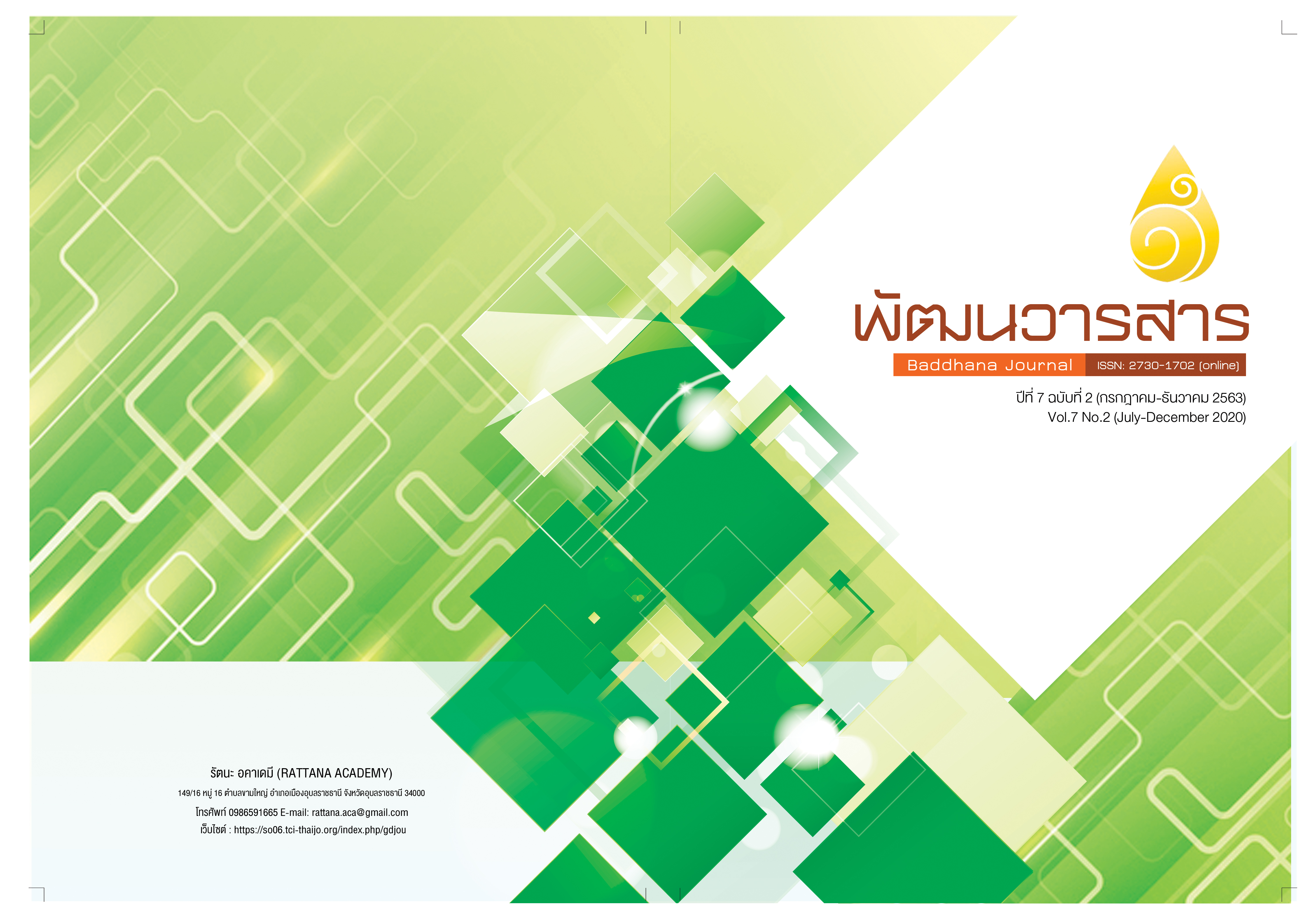การส่งเสริมศักยภาพ รูปแบบการส่งเสริมศักยภาพผู้ผลิตซอฟต์แวร์และบริการซอฟต์แวร์โดยใช้เทคนิคการโคชชิ่งตามสไตล์การเรียนรู้แบบ VARK เพื่อให้สอดคล้องกับความต้องการของผู้ประกอบการและอุตสาหกรรมซอฟต์แวร์
Main Article Content
Abstract
This research has the objectives as follows: 1) To develop a model for enhancing the potential of software vendors and software services, 2) To assess the suitability of the model to enhance the potential of software vendors and software services. Research methodology was divided into 2 parts which were 1) Model synthesis; Sample group was 9 experts in model development who were selected by specific samples method. Data were collected by using a synthetic record, in-depth interview. Then the interviewees' data were analyzed by content synthesis. 2) Model suitability assessment; Sample group used in this part of the research was 5 qualified people in model suitability assessment who were selected by specific samples method. Research tool was an evaluation form. Statistics used for data analysis were mean and standard deviation. The results of the research showed that:
- The synthesized model consists of 4 components which are learner module, instructor module, learning module, and multi-coach module, with 4 learning process include Talk, Teach, Task, and Test.
- Evaluation result of the suitability of the potential enhancement model of software vendors and software services from the experts, it was found that the evaluations of all 4 aspects were appropriate at high level ( = 4.21, = 0.59).
Article Details
References
พ.ศ. 2545. กรุงเทพ ฯ: คุรุสภาลาดพร้าว.
กระทรวงเทคโนโลยีสารสนเทศและการสื่อสารร่วมกับสถาบันวิจัยและให้คำปรึกษาแห่งมหาวิทยาลัยธรรมศาสตร์.
(2557). ร่างแผนแม่บทเทคโนโลยีสารสนเทศและการสื่อสาร (ฉบับที่ 3) ของประเทศไทย พ.ศ.2557-2561.
กรุงเทพฯ: เทคโนโลยีสารสนเทศและการสื่อสาร.
กิตติพงศ์ พร้อมวงศ์ และคณะ. (2553). รายงานฉบับสมบูรณ์โครงการศึกษาอุตสาหกรรมซอฟต์แวร์เพื่อการพัฒนา
ประเทศไทย. (ออนไลน์). (อ้างเมื่อ 23 มีนาคม 2561). จาก:https://www.slideshare.net/softwarepark/
ss-9210978.
ธนชาติ นุ่มนนท์. (2559). วิกฤติบุคลากรไอซีทีไทย สุดท้าย Digital Economy คงไปไม่ถึงไหน. (ออนไลน์).
(อ้างเมื่อ 1 ธันวาคม 2560). จาก:https://thanachart.org/2016/06/17/วิกฤติบุคลากรไอซีทีไทย/
ธีรวุฒิ บุณยโสภณ และคณะ. (2550). การศึกษาเพื่อวางแผนกลยุทธ์การพัฒนาอุตสาหกรรมซอฟต์แวร์และ
เทคโนโลยีอิเล็กทรอนิกส์. วารสารวิชาการพระจอมเกล้าพระนครเหนือ, 17(2), 71-78.
บีสุดา ดาวเรือง และคณะ. (2561). กลไกการปรับเหมาะสำหรับการจดัรูปแบบการเรียนรู้แบบสัดส่วนตามรูปแบบ
VARK. (ออนไลน์). (อ้างเมื่อ 11 กุมภาพันธ์ 2561). จาก: https://www.researchgate.net/profile/
Beesuda_Daoruang/publication.
บุญชม ศรีสะอาด. (2553). การวิจัยเบื้องต้น. พิมพ์ครั้งที่ 2. กรุงเทพฯ: สุวิริยาสาส์น.
พิสุทธา อารีราษฎร์. (2552). การพัฒนารูปแบบการสอนใช้คอมพิวเตอร์ช่วยเรียนแบบอัจฉริยะผ่านเครือข่าย
คอมพิวเตอร์ รายวิชาเทคโนโลยีสารสนเทศเพื่อชีวิต. วารสารมหาวิทยาลัยราชภัฏมหาสารคาม, 3(1),
123-132.
ภาวิณี โสธายะเพ็ชร. (2558). 5Ts กับความสำเร็จด้านครุศึกษาของประเทศฟินแลนด์. วารสารครุศาสตร์
จุฬาลงกรณ์มหาวิทยาลัย, 43(3), 65-81.
วิจารณ์ พานิช. (2556). ครูเพื่อศิษย์ สร้างห้องเรียนกลับทาง. กรุงเทพฯ: เอสอาร์พริ้นติ้งแมส โปดักส์.
สถาบันวิจัยเพื่อการพัฒนาประเทศไทย. (2557). ความต้องการกําลังคนเพื่อวางแผนการผลิตและพัฒนา
กําลังคน ในระดับกลุ่มจังหวัดและกรุงเทพมหานคร. (ออนไลน์). (อ้างเมื่อ 28 กรกฎาคม 2560). จาก:
www.mol.go.th.
สมชาย สุขสิริเสรีกุล. (2551). การประเมินผลการลงทุนพัฒนาฝีมือทักษะแรงงานที่มีต่อรายได้และการกระจาย
รายได้ ของแรงงานไทย : รายงานการวิจัยฉบับสมบูรณ์. กรุงเทพฯ : สถาบันทรัพยากรมนุษย์ มหาวิทยาลัยธรรมศาสตร์.
สํานักงานคณะกรรมการการอุดมศึกษา. (2557). กระบวนการจัดทําแผนยุทธศาสตร์อุดมศึกษา (Workflow).
(ออนไลน์). (อ้างเมื่อ 16 ธันวาคม 2560) จาก: http://www.mua.go.th/users/bpp/developplan/
download.htm.
สำนักงานคณะกรรมการการอุดมศึกษา. (2550). กรอบแผนอุดมศึกษาระยะยาว 15 ปีฉบับที่ 2 (พ.ศ. 2551–2556).
กรุงเทพ ฯ: โรงพิมพ์แห่งจุฬาลงกรณ์มหาวิทยาลัย.
สำนักงานส่งเสริมอุตสาหกรรมซอฟต์แวร์แห่งชาติและสถาบันวิจัยเพื่อการพัฒนาประเทศไทย. (2558). รายงาน
สรุปผลการสำรวจข้อมูลตลาดซอฟต์แวร์และบริการซอฟต์แวร์ ประจำปี 2558. กรุงเทพฯ : สถาบันไอ
เอ็มซี.
Allington, R. (2012). The Six Ts of Effective Elementary Literacy Instruction. (online) (Retrieved 20
February 2018). available from: http://www.readingrockets.org/article/six-ts-effective-
elementary-literacyinstruction.
Bernie Trilling and Charles Fadel. (2009). 21st Century Skills: Learning for Life in Our Times.
New York: Jossey-Bass A Wiley Imprint.
Cardno, A.G. and Gottesman, I.I. (2000) Twin studies of schizophrenia: From bow-and-arrow
concordances to Star Wars Mx and functional genomics. American Journal of Medical
Genetics, 97, 12-17.
DePorter, Bobbi dan Mike Hernacki. terjemahan Alwiyah Abdurrahman. (2009). Quantum Learning
: Membiasakan Belajar Nyaman dan Menyenangkan. Bandung: Kaifa.
Fleming, N.D. (2001). Teaching and learning styles: VARK strategies. Christchurch: N.D.
Joyce, B. R., & Showers, B. (2002). Student achievement through staff development (3rd ed).
Alexandria, Virginia: Association for Supervision & Curriculum Deve (ASCD).
Marquardt, M. and Banks, S. (2004). Theory to Practice: Action Learning. New York: George
Washington University.
Sprenger, M. (2003). Differentiation through learning styles and memory. Thousand Oaks.
New York: Corwin.
Watson Todd, R. (2006). "Continuing Change after the Innovation", System, 34(1), March, pp. 1-14.


